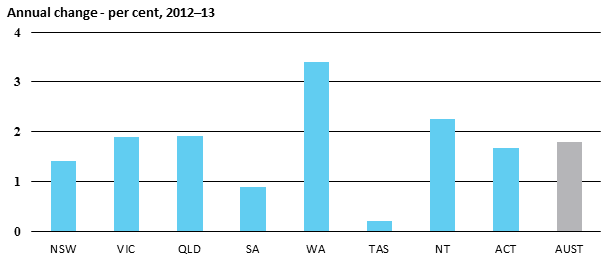
| |
2008-09
|
2009-10
|
2010-11
|
2011-12
|
2012-13
|
| Population (a) – '000 |
| New South Wales |
7053.8
|
7144.3
|
7218.5
|
7307.2
|
7409.6
|
| Victoria |
5371.9
|
5461.1
|
5537.8
|
5632.5
|
5738.9
|
| Queensland |
4328.8
|
4404.7
|
4476.8
|
4568.2
|
4655.0
|
| South Australia |
1608.9
|
1627.3
|
1639.6
|
1656.0
|
1670.7
|
| Western Australia |
2240.3
|
2290.8
|
2353.4
|
2438.0
|
2520.6
|
| Tasmania |
504.4
|
508.8
|
511.5
|
512.1
|
513.1
|
| Northern Territory |
226.0
|
229.8
|
231.3
|
235.9
|
241.2
|
| Australian Capital Territory |
354.8
|
361.8
|
368.0
|
375.2
|
381.5
|
| Australia |
21691.7
|
22031.8
|
22340.0
|
22728.3
|
23133.7
|
| Annual change – per cent |
| New South Wales |
1.6
|
1.3
|
1.0
|
1.2
|
1.4
|
| Victoria |
2.2
|
1.7
|
1.4
|
1.7
|
1.9
|
| Queensland |
2.6
|
1.8
|
1.6
|
2.0
|
1.9
|
| South Australia |
1.3
|
1.1
|
0.8
|
1.0
|
0.9
|
| Western Australia |
3.2
|
2.3
|
2.7
|
3.6
|
3.4
|
| Tasmania |
1.2
|
0.9
|
0.5
|
0.1
|
0.2
|
| Northern Territory |
2.8
|
1.7
|
0.7
|
2.0
|
2.3
|
| Australian Capital Territory |
1.8
|
2.0
|
1.7
|
2.0
|
1.7
|
| Australia |
2.1
|
1.6
|
1.4
|
1.7
|
1.8
|
| |
|
|
|
|
|
| (a) Estimated resident population numbers are as at June of each year. |
| Source: ABS, Australian Demographic Statistics, Cat. no. 3101.0, December 2013 |
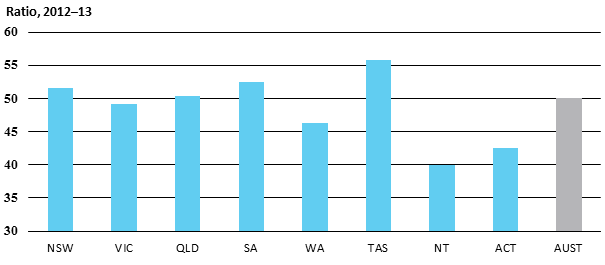
| |
2008-09
|
2009-10
|
2010-11
|
2011-12
|
2012-13
|
| Dependency ratio (a) |
| New South Wales |
49.5
|
49.9
|
50.3
|
51.0
|
51.6
|
| Victoria |
47.4
|
47.5
|
47.8
|
48.5
|
49.1
|
| Queensland |
48.2
|
48.6
|
49.0
|
49.7
|
50.3
|
| South Australia |
50.2
|
50.4
|
50.8
|
51.7
|
52.5
|
| Western Australia |
45.7
|
45.8
|
45.8
|
46.0
|
46.2
|
| Tasmania |
52.9
|
53.1
|
53.5
|
54.7
|
55.7
|
| Northern Territory |
39.6
|
39.4
|
39.5
|
39.8
|
40.0
|
| Australian Capital Territory |
39.7
|
39.9
|
40.4
|
41.5
|
42.5
|
| Australia |
48.1
|
48.4
|
48.8
|
49.4
|
50.0
|
| |
|
|
|
|
|
(a) The ratio shows the number of children aged 0–14 years and persons aged 65 years and over,
per 100 persons aged 15–64 years. |
| Source: ABS, Australian Demographic Statistics, Cat. no. 3101.0, Mar 2014 |
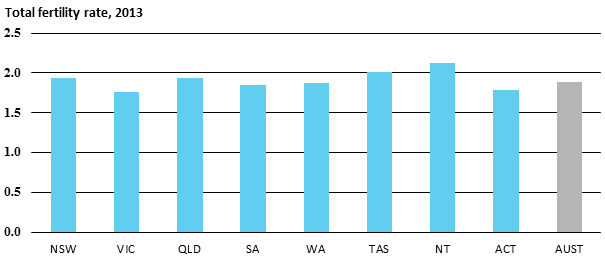
| |
2009
|
2010
|
2011
|
2012
|
2013
|
| Births – number |
| New South Wales |
98 231
|
101 266
|
99 054
|
98 508
|
100 462
|
| Victoria |
70 928
|
70 572
|
71 444
|
77 405
|
73 969
|
| Queensland |
66 149
|
64 523
|
63 253
|
63 837
|
63 354
|
| South Australia |
19 735
|
20 078
|
19 892
|
20 433
|
20 090
|
| Western Australia |
30 879
|
31 424
|
32 259
|
33 627
|
34 516
|
| Tasmania |
6 627
|
6 385
|
6 608
|
6 168
|
6 049
|
| Northern Territory |
3 820
|
3 899
|
3 954
|
4 104
|
4 053
|
| Australian Capital Territory |
4 860
|
5 152
|
5 121
|
5 461
|
5 545
|
| Australia |
301 253
|
303 318
|
301 617
|
309 582
|
308 065
|
| Total fertility rate (a) |
|
|
|
|
|
| New South Wales |
1.978
|
2.020
|
1.963
|
1.930
|
1.940
|
| Victoria |
1.826
|
1.785
|
1.778
|
1.888
|
1.765
|
| Queensland |
2.174
|
2.087
|
2.017
|
1.995
|
1.940
|
| South Australia |
1.892
|
1.897
|
1.868
|
1.898
|
1.848
|
| Western Australia |
1.951
|
1.936
|
1.918
|
1.909
|
1.870
|
| Tasmania |
2.172
|
2.079
|
2.155
|
2.036
|
2.013
|
| Northern Territory |
2.104
|
2.119
|
2.147
|
2.196
|
2.117
|
| Australian Capital Territory |
1.722
|
1.782
|
1.735
|
1.791
|
1.784
|
| Australia |
1.970
|
1.954
|
1.917
|
1.930
|
1.882
|
| |
|
|
|
|
|
| (a) The average number of children that females will bear during their lifetime. |
| Births statistics are based on calendar year of registration. |
| Source: ABS, Births, Cat. no. 3301.0, 2013 |
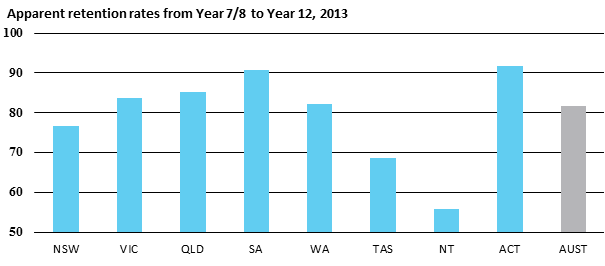
| |
2009
|
2010
|
2011
|
2012
|
2013
|
| Apparent retention rates from Year 10 to Year 12 (a) |
| New South Wales |
73.5
|
74.5
|
76.7
|
75.5
|
75.8
|
| Victoria |
81.2
|
82.1
|
82.0
|
81.2
|
83.1
|
| Queensland |
78.8
|
81.0
|
81.8
|
82.2
|
84.0
|
| South Australia |
77.5
|
80.6
|
83.9
|
86.3
|
87.8
|
| Western Australia |
73.5
|
76.5
|
76.4
|
77.8
|
81.0
|
| Tasmania |
64.1
|
70.7
|
70.0
|
67.1
|
67.8
|
| Northern Territory |
62.3
|
61.4
|
62.9
|
62.1
|
62.9
|
| Australian Capital Territory |
88.8
|
91.8
|
90.0
|
89.3
|
90.4
|
| Australia |
76.7
|
78.5
|
79.5
|
79.3
|
80.7
|
| Apparent retention rates from Year 7/8 to Year 12 (b) |
| New South Wales |
71.3
|
72.5
|
74.6
|
75.0
|
76.7
|
| Victoria |
80.2
|
81.1
|
82.0
|
82.2
|
83.7
|
| Queensland |
79.6
|
82.5
|
83.0
|
83.7
|
85.2
|
| South Australia |
78.5
|
81.9
|
86.3
|
88.8
|
90.6
|
| Western Australia |
75.0
|
78.3
|
78.4
|
79.5
|
82.2
|
| Tasmania |
63.8
|
71.0
|
69.8
|
67.6
|
68.7
|
| Northern Territory |
54.8
|
53.0
|
55.3
|
55.6
|
55.8
|
| Australian Capital Territory |
86.9
|
90.8
|
89.4
|
89.8
|
91.6
|
| Australia |
76.0
|
78.0
|
79.3
|
79.9
|
81.6
|
| |
|
|
|
|
|
(a) The number of full-time school students in Year 12 expressed as a percentage of the corresponding
group at the commencement of their Year 10 schooling. |
(b) The number of full-time school students in Year 12 expressed as a percentage of the corresponding
group at the commencement of their secondary schooling. |
| Source: ABS, Schools, Cat. no. 4221.0, 2013 |
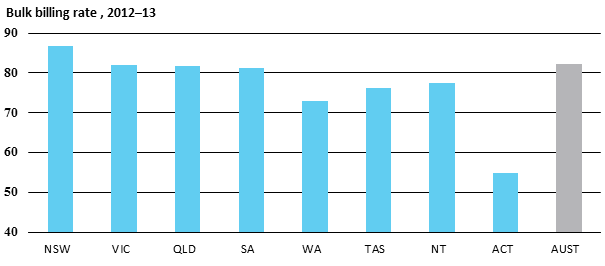
| |
2008-09
|
2009-10
|
2010-11
|
2011-12
|
2012-13
|
| General practice bulk billing rate (a) – per cent |
| New South Wales |
84.7
|
84.4
|
85.0
|
85.9
|
86.8
|
| Victoria |
77.3
|
78.2
|
79.1
|
80.5
|
82.0
|
| Queensland |
77.3
|
78.9
|
79.8
|
80.6
|
81.6
|
| South Australia |
79.4
|
78.7
|
78.9
|
80.5
|
81.3
|
| Western Australia |
72.4
|
72.5
|
72.3
|
72.4
|
72.9
|
| Tasmania |
73.4
|
74.3
|
74.7
|
74.8
|
76.1
|
| Northern Territory |
62.3
|
65.6
|
68.2
|
72.0
|
77.4
|
| Australian Capital Territory |
51.1
|
47.1
|
46.0
|
49.5
|
54.9
|
| Australia |
79.2
|
79.5
|
80.2
|
81.2
|
82.2
|
|
|
|
|
|
|
(a) Proportion of general practitioner attendances (excluding practice nurse), enhanced primary care and
other non-referred attendances that are bulk billed. |
Source: Department of Health and Ageing, http://www.health.gov.au/internet/wcms/
publishing.nsf/Content/Statistics-1, accessed on August 2014. |
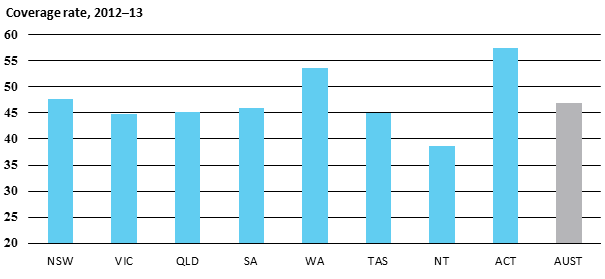
| |
2008-09
|
2009-10
|
2010-11
|
2011-12
|
2012-13
|
| Private health insurance hospital coverage rate (a) – per cent |
| New South Wales |
45.7
|
46.2
|
46.9
|
47.4
|
47.6
|
| Victoria |
43.6
|
44.0
|
44.3
|
44.6
|
44.7
|
| Queensland |
43.3
|
43.8
|
44.4
|
45.0
|
45.2
|
| South Australia |
45.1
|
45.4
|
45.6
|
45.9
|
46.0
|
| Western Australia |
50.6
|
51.5
|
52.2
|
53.1
|
53.5
|
| Tasmania |
43.1
|
43.3
|
43.9
|
44.5
|
44.9
|
| Northern Territory |
34.8
|
35.9
|
37.0
|
38.0
|
38.7
|
| Australian Capital Territory |
54.5
|
55.3
|
56.1
|
56.9
|
57.4
|
| Australia |
45.1
|
45.6
|
46.2
|
46.7
|
47.0
|
| |
|
|
|
|
|
(a) Proportion of the population that has private health insurance hospital coverage as of the June quarter
in each financial year. |
Source: Private Health Insurance Administration Council, http://www.phiac.gov.au/statistics/trends/index.htm,
accessed August 2014. |
For copyright reasons some linked items are only available to members of Parliament.
© Commonwealth of Australia
Creative Commons
In essence, you are free to copy and communicate this work in its current form for all non-commercial purposes, as long as you attribute the work to the author and abide by the other licence terms. The work cannot be adapted or modified in any way. Content from this publication should be attributed in the following way: Author(s), Title of publication, Series Name and No, Publisher, Date.
To the extent that copyright subsists in third party quotes it remains with the original owner and permission may be required to reuse the material.
Inquiries regarding the licence and any use of the publication are welcome to webmanager@aph.gov.au.
This work has been prepared to support the work of the Australian Parliament using information available at the time of production. The views expressed do not reflect an official position of the Parliamentary Library, nor do they constitute professional legal opinion.
Any concerns or complaints should be directed to the Parliamentary Librarian. Parliamentary Library staff are available to discuss the contents of publications with Senators and Members and their staff. To access this service, clients may contact the author or the Library‘s Central Entry Point for referral.